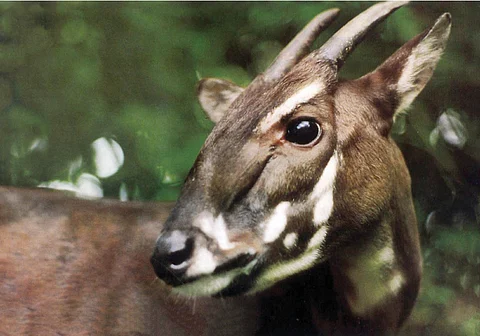

An international team of scientists has mapped the genome of the saola (Pseudoryx nghetinhensis), the rarest large land mammal in the world.
The researchers analysed fragments from saola remains collected from hunters’ households to generate complete genomes for 26 saolas.
They also found that the bovine spilt into two populations between 5,000 and 20,000 years ago. This split coincided with likely changes in the distribution of dense forest habitat during and after the Last Glacial Maximum.
“The transition of human societies from a hunter-gatherer to an agricultural lifestyle, which occurred around 4 kya in present-day Vietnam, could have contributed to the genetic isolation between two saola populations through an expansion of human activities, such as hunting, burning, and rice cultivation, and associated forest losses in the area,” the researchers wrote.
Both populations began losing genetic diversity. But crucially, they did not lose the same genetic diversity.
“This means that the genetic variation lost in each population complements the other. So, if you mix them, they could compensate for what the other is missing,” lead author Genís Garcia Erill was quoted as saying by website Phys.org.
The results from the study are of importance for the saola. It was not scientifically described until 1993, making it the most recently described large land mammal.
Found in the misty highland forests of the Annamite mountain range along the border between Vietnam and Laos, the saola has yet to be observed alive by scientists in its natural habitat, despite the efforts of several research teams and conservation bodies.
“Our very limited knowledge about this elusive animal is largely drawn from physical remains (primarily skulls and a few skins), anecdotes collected from inhabitants of the region, and five observations from camera-trapping surveys in Vietnam and Laos,” noted the researchers.
The saola is categorised as ‘Critically Endangered’ on the International Union for Conservation of Nature’s Red List, with a population size assessed in 2015 to be 50-300 individuals.
Its continued survival is in doubt, with the species facing threats from indiscriminate snaring and disturbance and loss of its forest habitat.
“Although over 20 individuals were captured alive by locals in the 1990s, attempts to keep them alive failed, likely due to a lack of professional care. Today, a major effort is underway to build a well-equipped captive breeding facility for saola in Vietnam, in the hope that live individuals can be captured and transferred to the facility as a last chance to save it from extinction. The plan is to use the captive population to reintroduce animals in a protected area where poaching is prevented,” according to the paper.
“If we can bring together at least a dozen saolas—ideally a mix from both populations—to form the foundation of a future population, our models show the species would have a decent chance of long-term survival. But it hinges on actually locating some individuals and starting a breeding program. That has worked before when species were on the brink of extinction,” Phys.org quoted Rasmus Heller, senior author of the study.
Genomes of critically endangered saola are shaped by population structure and purging has been published in the journal Cell.